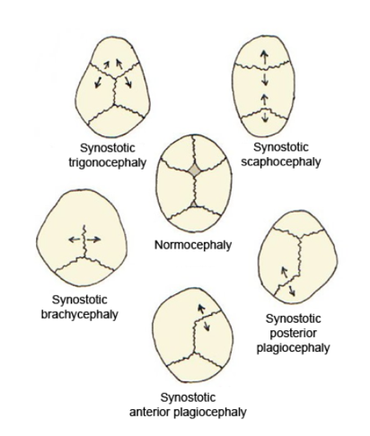Craniofacial surgery
Craniofacial surgery is a surgical subspecialty that deals with congenital and acquired deformities of the head, skull, face, neck, jaws and associated structures.In cases in which the compensation does not effectively provide enough space for the growing brain, craniosynostosis results in increased intracranial pressure.Premature fusion of this suture causes the forehead to become pointed, giving the head a triangular shape when viewed from above (Greek trigono, "triangle").[9] Craniofacial surgery and follow-up care are usually conducted by a multidisclinary team of doctors, surgeons, nurses, and various therapists.[10] As of 2016, there is a new multidisciplinary care team of Neuroplastic Surgeons working with Neurosurgeons to prevent and/or correct neurosurgical-related deformities and to maximize outcomes in adult patients.In cases where the forehead is involved (trigonocephaly and plagiocephaly), a technique called fronto-supraorbital advancement is used to correct the shape of the head.The procedure is performed at a young age in order to provide the brain with enough space to grow and prevent further abnormal growth of the skull.If a scaphocephaly is diagnosed within 4 to 5 months after birth, it can be corrected with a relatively simple procedure whereby the sagittal suture is surgically reopened.The first center of Neuroplastic Surgery was started at Johns Hopkins by Dr. Chad Gordon and the Department of Neurosurgery, which is where this new craniofacial subspecialty was born (c. 2016).



subspecialtycongenitaldeformitiessurgeonscraniosynostosiscraniofacial cleftscleft lip and palateTreacher Collins SyndromeApert's SyndromeCrouzon's Syndromeoral and maxillofacial surgeryplasticreconstructive surgeryear, nose, and throat surgerysuturesPlastic surgeryOrthognathic SurgeryScalp reconstructionZygoma reduction plastyNeuroplastic SurgeryCraniofacial Fellowship